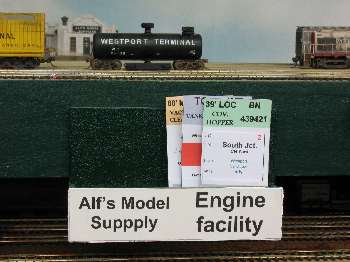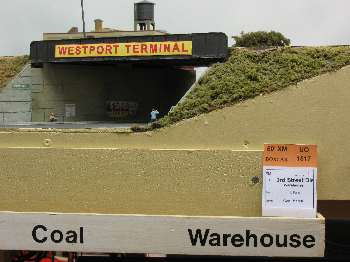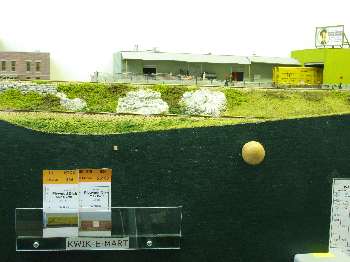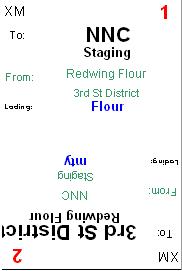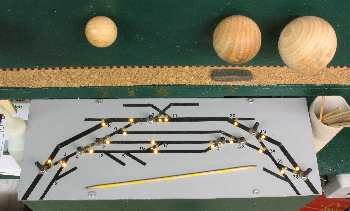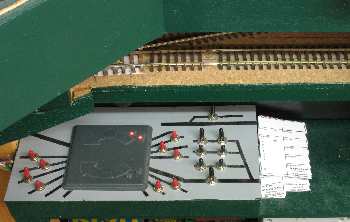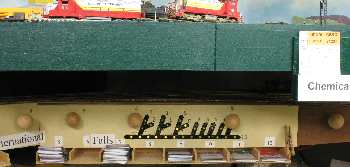WESTPORT TERMINAL RR |
BLT 1999 update Feb 2009 |
[How to scratch build turnouts] and [crossings] [Manual thrown Peco turnouts] [switch stands] [Movable magnets] [DCC] [beacon light] [CB&Q 173] [RS-1 and weathering] [tender pick up 0-8-0] [ Track Cleaning Transfer Caboose ] [ Signal Bridge ] [Operation] [Way of Hopper BN 25 3 84] [WT RR industries shipping & receiving] download Excel [carcards&waybills] 900kB [staging] [Harbor District] [Plywood District] [Third Street Industrial District] [track scale, structures] [Operating gates] [Waterfront Structures] [trestle] [Interchange Cars] [car exchange] [pass exchange] [electronic rail pass ] [ video ] |
Diese Seite auch auf
Deutsch. ![]()
Operation and Concept and Sessions
For operation I use timetable and car cards. How To car cards & waybills

download Excel carcards or only waybills FREMO-style or 4-position-waybills
AAR types for model railroad use
Gerry Hopkins MMR used and processed it.
or as .zip file carcards&waybills.zip
trainsheet and timetable: WTsystem.xls
For the car cards are the boxes at the fascia:
You pick up only cars with "your" destination. This is in the train instruction e.g.for this local.

| Because, I've a loop, trains from Westport to Third Street District run via Harbor Jct. and trains to Harbor District run via Third Street. In this way I get a longer more interesting run. |
THE TIMETABLE

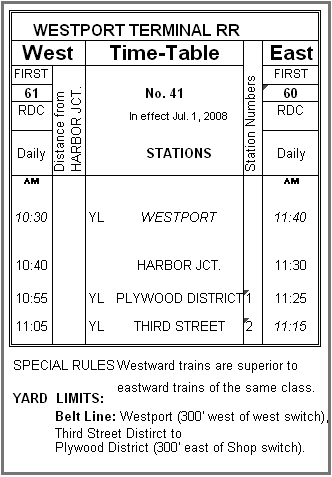
The Second Division has only one scheduled RDC.
THE TRAINSPassenger:
Commuter and RDC Beetween South Junction and International Falls with stop at Westport. RDC's via Harbor Jct. to Third Street Industrial District and return. Freight: Through and Transfer
There're two transfer turns. One from International Falls to Westport and back and the other from South Jct. to Westport and back. And there's a Grain unit from Thunder Bay to Winnipeg as well as the Valley sweeper with cars bound for Diamond Valley. Extras
From Westport to Harbor District and back as Extra. Also in the afternoon. This train sets out cars at Third Street District and pick up cars on the return. Also there's a turn to the Plywood District. It runs on demand as extra. Other trains like unit coal or unit grain run as extra. |
|||||||||
Operating Session |
|||||||||
|
|||||||||
| Each car has a car card with a pocket for the waybill. The prototype has e.g. a tack board at the cars for the freight papers. The waybill has 4 positions. After the session when the car is delivered and loaded/unloaded the waybill is turned to the next position. This will not be done after each session. | |||||||||
|
|||||||||
Agreements |
|||||||||
| The operator looks north. East is to the right, west is to the left.
All turnouts are manually thrown. (With push-pull-rod or -like partially at 3rd Street District - by switch motor. Exception: Harbor Jct. and South Jct. These turnouts are operated by the dispatcher. |
|||||||||
Types of Trains |
|||||||||
| Passenger run between International Falls and South Jct., partially via 3rd Street District, Plywood District. | |||||||||
| Hotshots run between South Jct (west staging) and International Falls (east staging). | |||||||||
| Transfer exchange cars between International Falls
respectively South Jct. and Westport. All other trains run as Extra. |
|||||||||
At the Throttle |
|||||||||
Safety first! |
|||||||||
| The bell must be rung | |||||||||
|
|||||||||
|
|||||||||
| The horn/whistle to be used: | |||||||||
|
|||||||||
|
|||||||||
|
|||||||||
|
|||||||||
Diesel engines have to use dynamic brakes when descending grades (if equipped with). |
|||||||||
| The FRED-card shows allocation for the buttons. Usually F0 - light/sound, F1 - bell, F2 horn/whisle ... | |||||||||
| * When approaching a stationary car, stop a cars length from
the car then approach at no more than 4mph. |
|||||||||
Speed |
|||||||||
In yard and industrial districts 10 mph |
|||||||||
Freights 35 mph |
|||||||||
Passengers 50 mph |
|||||||||
| Coupling: stop 1/2 car length from the car then approach with less than 4 mph. | |||||||||
| Uncoupling: Use magnets or uncouple sticks like: |
|||||||||
Don't touch the
cars. Don't touch the roofs! (You
may push/stop at the coupler!) |
|||||||||
| Air brake test: Type of operation Initial terminal air test Brake pipe leakage test Rear-end set and release. 2 (fast) min per car. | |||||||||
Conductor |
|||||||||
| Now, I'm using track warrant. Each train has conductor (responsible) and engineer. Op session goes with Track Warrant. That means for each train there's a (verbal) order from the dispatcher. Is the Track Warrant fulfilled, the limits are clear the train reports this to the dispatcher. |
|||||||||
| Info: Track Warrant control by Carsten S. Lundsten and General Code of Operating Rules (GCOR) | |||||||||
| And this is an examples of trainorders, written with font "DOT MATRIX" and "John Doe". Any improvements? | 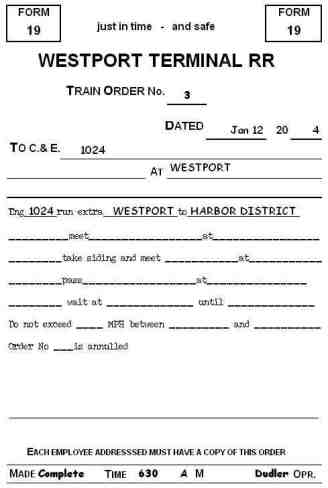 |
And the last step in paperwork is my trainsheet, this is one session, but it lasts weeks for me:


example: friday night
AAR Car types for model railroad use
Control panels
next top
| [How to scratch build turnouts] and [crossings] [Manual thrown Peco turnouts] [switch stands] [Movable magnets] [DCC] [beacon light] [CB&Q 173] [RS-1 and weathering] [tender pick up 0-8-0] [ Track Cleaning Transfer Caboose ] [ Signal Bridge ] [Operation] [Way of Hopper BN 25 3 84] [WT RR industries shipping & receiving] download Excel [carcards&waybills] 900kB [staging] [Harbor District] [Plywood District] [Third Street Industrial District] [track scale, structures] [Operating gates] [Waterfront Structures] [trestle] [Interchange Cars] [car exchange] [pass exchange] [electronic rail pass ] [ video ] |
